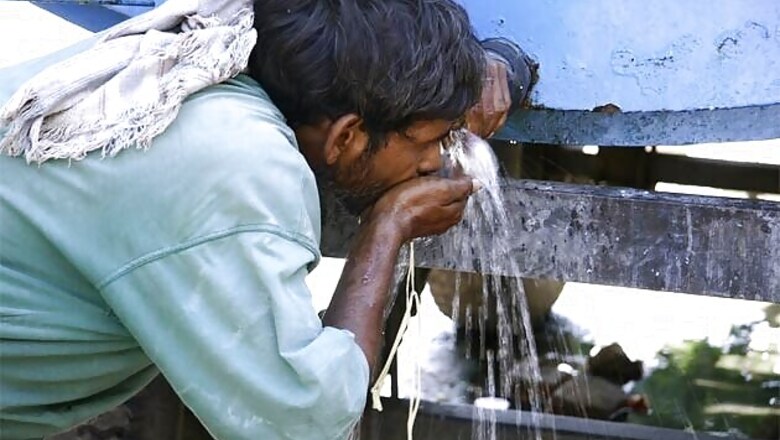
views
Recent media reports (The Hindu, December 28, 2014) of death and diseases by the consumption of alleged 'contaminated and poisonous' water of rivers such as the Kali, the Krishna, and the Hindon in UP and the subsequent inquiry order by the Prime Minister's office into the incident, present a snapshot of the water quality in India.
On the whole, India's water sector shows a dismal scenario when one looks into its quality. India's available water resources, of which irrigation sector consumes the most, are used for different purposes. Irrigation uses surface water as well as ground water, and so is the case with domestic and industrial uses. About 70 percentage of the surface water and ground water is contaminated.
Water quality is measured by many 'beyond threshold level' parameters: in the case of fresh water, these, inter alia, include biological oxygen demand (BOD) level, level of total coliform and faecal coliform, while for ground water, level of trace elements, extent of saline-fresh water interface, inter alia, determine the level of contamination. Such trace elements may include arsenic, heavy metals etc. A recent report of Central Pollution Control Board (CPCB 2013) points out contamination of river water at identified points when measured, inter alia, in terms of BOD, and coliform bacterial count, thus indicating the extent of water quality degradation in different parts of India. In the case of ground water, inland salinity, coastal salinity, fluoride, arsenic, iron, nitrates are some of the contaminants. States such as Rajasthan, Gujarat, Bihar, Assam, amongst others, are affected by such contamination.
The root causes of contamination of river water, inter alia, include inefficient functioning of ETPs (Effluent Treatment Plants), CETPs (Common Effluent Treatment Plants), STPs (Sewage Treatment Plants) resulting in dumping of untreated industrial wastes into the river; discharging of untreated municipal wastes into river; lack of onsite treatment of contaminants; non point sources of pollution including pesticide contaminated agricultural run off, piling up of materials at most river banks for religious uses etc. In the case of ground water, contamination results due to excessive drawal of ground water resulting in inland salinity, due to saline water overlying fresh water acquifer, presence of fluoride mineral in both igneous and sedimentary rocks, use of arsenic and its compounds in pigments as pesticides and herbicides etc. For example, against all India average of ground water withdrawal of 61 percentage, Punjab and Haryana withdraw more than 100 percentage, and thus, inland salinity is more prevalent in arid/semi arid region of these states. The presence of arsenic is seen in the intermediate aquifers of 200-100 m range while deep aquifer is free of this problem.
It is in the above context, 'Swachh Bharat Abhiyan', and the 'Namami Gange' campaign announced by the Central Government on a priority basis are timely. However, multi pronged concerted actions are needed at all levels to make such efforts meaningful. Some of the suggested steps are:
First, monitoring of water quality, as is being done by statutory authorities such as CPCB, needs to be more broad based covering maximum testing points on various rivers, and has to be undertaken on real time basis. It must be known how the industrial effluents above the permissible level are being discharged along the river line on instantaneous basis. Based on these, effective mitigating action can be taken either for stopping the discharge of untreated industrial effluents into the river, or remedying it through effective and continuous treatment with combined regulatory and incentive mechanisms.
Second, in case of most of the cities and the towns situated on the river side, discharge of untreated municipal waste into river is a regular phenomena. For example, at Patna, the Rajpur drain running parallel to the Ganga discharges the drainage of the entire city into river, thus contributing to the high faecal coliform content of the river. Similarly, take the case of Gurgaon city, which claims to treat about 50-60% sewerage generated daily and discharges them into the Yamuna river, but the rest is left on open land, allowing it to seep into the ground, thus contaminating the ground water. The real challenge is how to motivate the municipal authorities which are starved of expertise and financial resources, for treatment of all city sewerage after intercepting the same at suitable points, before discharging them into the river or otherwise.
Third, non point pollution coming from varied sources (e.g run off from agricultural fields) carry sediments, chemicals or pesticides. There is a need to arrest generation of contaminants before they become mobile or treat pollutants already in transit before they reach the river. Preventive measures such as structural, non structural methods, source control measures, or treatment of pollutants in transit, can be used depending on the situation. For example, structural measures may include developing sediment ponds while education of public could be one of the non structural measures. Multiple models are available on the subject, and the applicability of such models in the Indian context has to be examined in depth.
Fourth, there is a need for effective institutional coordination at various levels. Water being a state subject, a high level of shared objectives among stakeholders for minimizing water pollution is required, and this is possible if the river basin states are brought to a common platform for resolving various issues. In this regard the Water Resources Council of the central government is the right forum, but this has to be effectively activated.
Fifth, a holistic approach is needed for managing ground water contamination. The central government's initiative for mapping the entire acquifer during the 12 th Five Year Plan and thereafter, is a timely initiative if implemented, but this needs to be supplemented with participatory management by various stakeholders. This is a gigantic task, as stakeholders need to be convinced on the efficacy of this approach and be involved. By knowing the acquifer status of ground water, various remedial actions such as recharging, rain water harvesting, removing ground water contamination can be undertaken in a joint collaborative arrangement between stakeholders and the government.
Sixth, massive awareness building program for various stakeholders is called for at the central, state, and sub national levels about the health hazards posed by the degraded water quality for various uses. Towards this campaign, civil society can play a big role to supplement the efforts of the government. In addition dissemination of such information by scientific communities, specialized bodies and governments on real time basis is also of paramount importance.
(SK Sarkar is a distinguished fellow in TERI, New Delhi and a former Secretary, Ministry of Water Resources, Government of India)




















Comments
0 comment